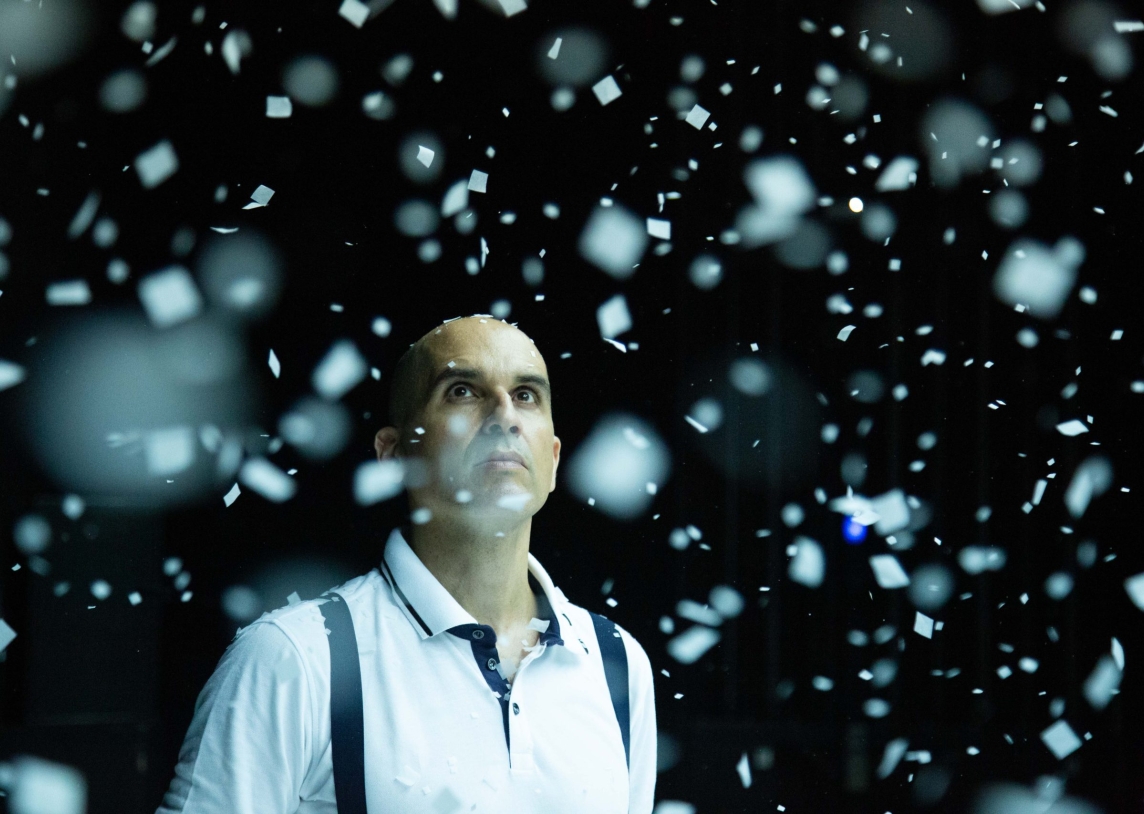- International Platform
- Content
Content
If a Consensus Is Reached, This Could Be a Really Good Mountain
Author: Maša Jazbec
"Statistically, the two adjectives most often assigned to the concept of truth are pure and untainted. Funny, when the truth is complex, contradictory and elusive. Just like reality."
The reality that the spectators experience when they enter the Kino Šiška auditorium is a stage on which numerous objects, gadgets and models are arranged on tables, with three large screens in between. In front of one of the screens we can see one of the performers lying on a kind of a mound, another screen serves as a net over which the other two performers will pass a shuttlecock to each other, and behind the third screen a fourth is waiting. The performers (all except the one lying on the cloth mound, who is dressed in early 20th-century mountaineering clothes) are dressed in sportswear that could easily be associated with the style of the aristocratic society of the modern world.
The action is interrupted by the only female performer (Anna Pérez Moya), who immediately introduces the main theme of the production. Questioning the truth. What is truth and what do we understand, perceive as truth in today's world? Agrupación Señor Serrano, a theatre group from Barcelona, which is now well-known to a wide range of audiences at home and abroad for its numerous productions (the group has been active since 2006, won the Silver Lion at the Venice Theatre Biennale in 2015, and in 2018 was a guest at the Lutke Festival, in addition to this year's edition), also follows its mission in the production of The Mountain. It takes stories, fragments of stories, from everyday life, mostly from the European continent, and transforms them into a new story of its own, in order to shake the spectators and to draw attention to the contradictory aspects of human and therefore also social existence.

Three stories are thus intertwined in The Mountain. One follows the still unconfirmed 1924 conquest of Mount Everest by the first English expedition with George Mallory, which includes correspondence between Mallory and his wife Ruth, the second questions the way fake news is created (online, radio, TV, social networks) through Orson Welles' controversial 1938 radio drama War of the Worlds, and the third story is embodied by an avatar of Russian President Vladimir Putin, who addresses those present with questions about truth, trust and control.
The time of its creation is of paramount importance for understanding and experiencing the performance. The play was first staged in the autumn of 2020, when strict sanitary measures were in place to contain a viral pandemic in most of the world. Notwithstanding the fact that the question of truth, reality and the perception of both has been a question in human history since its beginning, the time of the global pandemic has deepened the doubts about what truth is, what is presented to us as truth and what actually constitutes the "real" reality. The emergence of multiple media and living with the digital seem to have fed this doubt in recent decades.

The creators of the production (Ferran Dordal, Àlex Serrano, Pau Palacios, directors and dramaturges, the latter two also perform alongside Pérez Moya and David Muñiz) have carefully woven this omnipresent doubt, digital technology and media into the action on stage. They constantly play with visual tricks and projections of footage, revealing known information about Mallory's difficult journey to the summit of Everest, artfully introducing associations with contemporary society in archival footage of Orson Welles (two striking clips are of Welles talking about the dangers of manipulation through the media's presentation of false information, where an allusion is made to the well-known social network Facebook, or in another clip where we wonder to what extent the misleading with false information was also deliberate), they use precise animation and the filming of models to depict the events and the sensation created by the news of the alien invasion (Welles’ controversial radio broadcast) in a small American town. Even a drone appears and flies over the action on stage and over the audience. Not only that, but Putin's avatar (digital masks, video programming, visual effects by Román Torre, David Muñiz and Jordi Soler Quintana), played by Pérez Moya, is presented as the "sherpa" who will lead us to the top of the mountain of knowledge and truth. The image of Vladimir Putin, embodied in a female performer and in a (deliberately) distorted image is both funny and shocking. The whole dramaturgy of the production is designed to prick the audience, to surprise them (at least to a certain extent), to make them uncomfortable about their own perception and unpacking of information, what it means to trust someone, to believe someone and to follow someone.
The interplay of all these stories, which do not follow each other in a linear way, but are scattered in such a way that an element of one story can already intervene associatively in another, is enriched in terms of motif and content by passages from an alleged (but not verified) correspondence between the mountaineer Mallory and his wife Ruth. The allusions to meditations on Plato's Cave, Hume's empirical philosophy, Berkeley's subjective idealism, etc., which appear in Ruth's letters, are reinforced by impressions from her life as a wife, mother, avid reader and thinker, as she writes of events, impressions of everyday life and inner experiences.

Despite a few slip-ups (the overly performative launching of artificial snow, sometimes the rhythm slowed down too much), Señor Serrano, with its minimalist acting stance and sophisticated technical skills, manages to examine, test and shake the notion of truth and reality from different starting points. Starting points that can keep the viewer and the audience stimulated even after leaving the auditorium.
If a consensus is reached, the statement can be true.
This publication is written in the context of the project "European Contemporary Puppetry Critical Platform"

